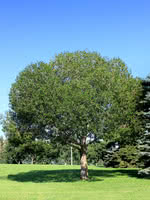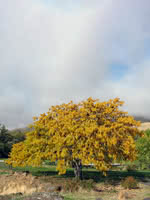Mon-Fri 9am - 5pm Mountain time
Laurel Leaf Willow vs Thornless Honeylocust
Salix pentandra
Gleditsia triacanthos inermis
Laurel Leaf Willow is a round-shaped tree with attractive dark green leaves.
This cold hardy tree can withstand bitter winters and still put on lots of growth every summer. Laurel Leaf Willow prefers moist to wet ground and full sun, though it can tolerate partial shade too. This species is also known as one of the more salt-tolerant species for those with saline soils.
All willow are important to native pollinators each spring as they have higher amounts of pollen and nectar early each growing season when other food sources are scarce.
Thornless Honey Locust makes an excellent shade tree with its lacy foliage and dappled shade. The leaves are honey-yellow, light and airy, providing interesting color and texture to your landscape. This variety is thornless, and the seeds and pods provide food for wildlife such as deer and squirrels.
The Thornless Honey Locust is tolerant of drought, various soil conditions, and even road salt.
Laurel Leaf Willow Quick Facts
Thornless Honeylocust Quick Facts
In row spacing: 2.4 - 3 m (8 - 10 ft)

